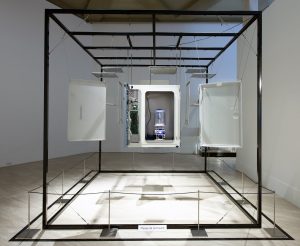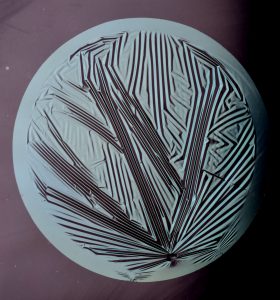In bio-art, artists and scientists use living tissues, bacteria and organisms to produce intriguing creations. These works are often intended to inspire conversations and action related to the environment, ecology and the effects of human interaction on nature. At Syracuse University, an interdisciplinary group of faculty have created an event called the Bio-Art Mixer, which brings together professors, graduate students and the general public to share innovative research, foster ideas for new art and research projects, and view new science-inspired art works from leading bio-artists around the world. The event is open to science and art enthusiasts, and anyone interested in finding out more about this emerging art form.

The conversation series was started in 2018 by Heidi Hehnly, assistant professor of biology in the College of Arts and Sciences and Boryana Rossa, associate professor, Transmedia Department in the College of Visual and Performing Arts (VPA). Rossa is an interdisciplinary artist and curator who works in the fields of electronic arts, film, video, performance and bio-art. Hehnly is a cellular biologist who specializes in studying the mechanics of cellular division and how and when cells in the body choose to divide.
A collaboration between Rossa and Hehnly on a project by Rossa titled, The Mirror of Faith, which premiered in 2019 at GARAGE Museum of Contemporary Art, Moscow, inspired the Syracuse Bio-Art Mixer. The bio-art work centered on the hypothetical existence of a gene that confers faith, bringing about conversations and questions about the future of genetics. Hehnly helped Rossa execute scientific aspects of the exhibit, and out of that partnership came the Bio-Art Mixer – an event where a scientist and artist would each present their research in a cross-disciplinary way in an effort to spark collaboration.
The mixer was typically held in Syracuse but transitioned to a fully online format due to the pandemic. The virtual connectivity has resulted in a larger viewing audience and an opportunity to connect with international bio-artists from their own labs and museums.

The next Bio-Art Mixer is April 23 at 7:30 p.m., and will feature talks by artists and researchers Oron Catts and Ionat Zurr, and Syracuse University professor Zhen Ma. Catts and Zurr are the founders of the internationally renowned Tissue, Culture & Art (TC&A) Project in Australia. Ma is the the Samuel and Carol Nappi Research Scholar in Biomedical and Chemical Engineering in the College of Engineering and Computer Science (ECS), and is a member of the BioInspired Institute, an interdisciplinary team of faculty scholars that research complex biological systems and develop and design smart materials to address global challenges in health, medicine and materials innovation.
About the Presenters
Oron Catts and Ionat Zurr formed the TC&A Project in 1996 in Perth, Australia. Their collaboration examines how tissue engineering can be used as a medium for artistic expression, with projects that explore lab-grown food, tissue cultured clothing, semi-living sculptures and the changing relationship between humans and nonhumans.
Their artwork has been exhibited by institutions including the Museum of Modern Art (MoMA), Mori Art Museum and the National Art Museum of China, and has also been featured in the New York Times, Washington Post, Wired, New Scientist, Time, Newsweek and other media outlets.
Zurr is a Senior Lecturer in Fine Art at the The School of Design, The University of Western Australia, and Catts is director and co-founder of SymbioticA Laboratory, Centre for Excellence in Biological Arts, The School of Human Sciences, The University of Western Australia. SymbioticA is an art school and artistic research center focusing on biological arts considered to be the first art-science laboratory of its kind.

Zhen Ma, director of the System Tissue Engineering and Morphogenesis (STE-Ma) Laboratory at Syracuse University, researches human stem cells and organoid technology. His presentation will focus around stem cell organoids, which are tiny, colorfully striking, three-dimensional masses of tissue made by growing stem cells in a laboratory. These living organoids are miniature versions of developing organs and exhibit characteristics of various biological systems from brain to intestine. His lab also generates heart organoids from human stem cells, using them to study the effects of toxic substances on developing embryos.
For more information or a link to the Zoom event, visit the Bio-Art Mixer Facebook page.

Previous Bio-Art Mixer held December 11, 2020
The Bio-Art Mixer held December 11 featured talks by artist Jennifer Willet, associate professor in the School of Creative Arts at the University of Windsor; Richard Pell, Curator at the Center for PostNatural History (CPNH) in Pittsburgh; and Joseph Paulsen, assistant professor of physics at Syracuse University. The evening concluded with a discussion moderated by Ed Morris, instructor and co-director of the Canary Lab in VPA’s Transmedia Department.
Previous Presenters
Jennifer Willet is founder and director of INCUBATOR Lab, an art/science research laboratory and studio in downtown Windsor, Canada. In her presentation, Willet introduced the audience to the INCUBATOR Lab facilities, research methods and highlighted a few of her artworks produced within this research laboratory framework. Her work resides at the intersection of art and science and explores the relationship between people and organisms within the lab and outside of it, looking at the responsibilities humans have to the environment and the effects of their interventions on nature. One example of her work is The Great Lakes Algae Organ, a bicycle propelled street organ that plays music and grows and displays living algae. She uses the organ as a talking point to discuss algae’s roles as a superfood, as the largest producer of oxygen in the atmosphere, as a possible source of biofuel and as an invasive species in the Great Lakes.

As curator at the Center for PostNatural History, Richard Pell collects living, preserved and documented organisms such as bacteria, animals and plants of postnatural origin,–e.g., those that have been intentionally and genetically altered by humans through selective breeding or genetic engineering. The CPNH operates a permanent museum in Pittsburgh, Pennsylvania, and has been featured in publications including National Geographic, Nature Magazine, American Scientist, Popular Science, New Scientist, The Guardian and Wired. In his presentation, Pell highlighted a selection of the organisms in the CPNH and talked about some of the international exhibitions he has been a part of.
Physicist Joseph Paulsen researches soft condensed matter; elasticity and geometry of thin sheets; and self-organization in disordered materials. His lab’s research on soft materials was recently featured in the journal Physical Review X. In that paper, his group explored how to produce and reproduce crumples on a plastic balloon, which could be important for real life applications like designing a synthetic skin or trying to understand the mechanics of biological tissue. By studying things as simple as a crinkled candy wrapper or a birthday balloon, Paulsen says researchers can learn things that are important for designing deployable satellites or understanding ripples in a cell membrane or the earth’s crust. In his presentation, Paulsen discussed how his lab generates wrinkle patterns and how those patterns uncover new physical principles.
by Dan Bernardi
